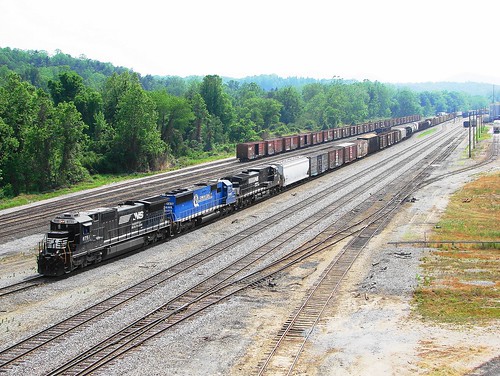Nation’s freight transportation system needs an efficiency boost, RAND researchers say
(Source: RAND & Progressive Railroading.com)
The U.S. freight transportation system’s long-term efficiency and effectiveness is “threatened” by capacity bottlenecks, inefficient use of some components of the freight infrastructure, interference with passenger transport, the system’s vulnerability to disruption, and the need to address important emission and energy constraints, according to a study recently released by RAND Corp.
Despite the global financial crisis, experts continue to estimate that there will be increased demand for freight transportation in the future, even as the capacity of the nation’s highways, port and railroads are nearing their limits in key urban areas and transportation corridors. The annual average road delay in the United States for rush hour travelers increased from 14 hours per year in 1982 to 38 hours per year in 2005. And the Association of American Railroads predicts that by 2035, more than half of the national rail network will be operating near or above capacity, resulting in significant travel delays and limiting the ability to maintain tracks and equipment. This would limit the opportunity to increase rail’s share of freight, which could help tackle environmental concerns and road congestion.
Titled “Fast Forward: Key Issues in Modernizing the U.S. Freight Transportation System for Future Economic Growth,” the study was supported by the Dow Chemical Co., U.S. Chamber of Commerce, Port Authority of New York and New Jersey, ports of Los Angeles and Long Beach, and Union Pacific Railroad. The authors provide a broad overview of U.S. freight transportation, discuss its role in the supply chains of various types of businesses, and provide data about its capacity in relation to demand for goods movement. They conclude with a discussion of the need to modernize the freight-transportation system and the overarching issues this involves: increasing capacity through operational improvements and infrastructure enhancement, making the system more adaptable and less vulnerable to disruption, addressing the energy and environmental concerns associated with freight transportation, and building support for public and private investment in the system.
The report description on RAND’s website offers the following: Efficient movement of freight within the United States and across its borders is a critical enabler of future U.S. economic growth and competitiveness.
Freight transportation system delays and “uncertainty in the performance of the system” have meant higher prices for consumers and reduced productivity, according to the study.
RAND researchers determined there are four freight transportation and infrastructure issues that need to be addressed:
• increasing national and international freight system capacity through a combination of operational improvements and selected infrastructure enhancements;
• creation of an adaptable, less-vulnerable and more-resilient freight transportation system;
• critical energy and environmental issues associated with freight transportation; and
• the pursuit of public and private investments in supply-chain infrastructure, and sustainable funding priorities.
The study also recommends that “responsible” agencies conduct system-level modeling of the freight transportation system to determine where bottlenecks occur and to understand vulnerabilities, and shippers be encouraged to use alternative ports to reduce strain on the system.
Increasing the nation’s freight transportation capacity can be done by using a variety of strategies, not just through a massive program of adding new roads or rail lines. Suggested strategies include regulations, pricing, technology, improved operating practices and selective infrastructure investments. Examples of these improvements include adopting congestion pricing to promote more highway transportation during non-peak hours, encouraging more goods to be shipped by rail instead of truck and expanding some port operations to run 24 hours a day, seven days a week.
To make the system more flexible and less vulnerable to disruption, the report recommends that responsible agencies conduct system-level modeling of the freight transportation system to determine where bottlenecks occur and to understand its vulnerabilities. Encourage shippers to use alternative ports, instead of relying on just the largest, also would reduce strain on the system.
Transportation accounts for 25 percent of the nation’s hydrocarbon fuel use; of that amount, about 25 percent is freight transportation. So while passenger vehicles are the primary energy users and emitters of pollution, the freight transportation industry also must consider environmental effects as it develops expansion plans. Methods to reduce pollution include increasing the operational efficiency of freight transportation (which also increases capacity) and such direct mitigation measures as cleaner fuel, better engines and more-aerodynamic vehicles.
Finally, the report suggests that a greater effort needs to be focused on developing sustainable priorities for public investment in the freight transportation system.
Click here to access the PDF version of the Full Report or the Executive Summary.







